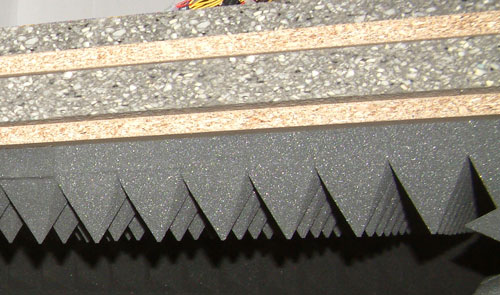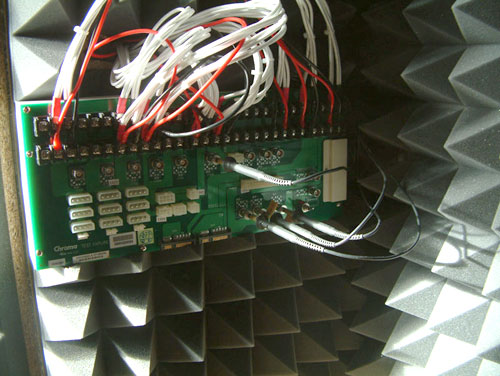Enermax Revolution 85+ High Efficiency PSU
by Christoph Katzer on November 6, 2008 4:15 AM EST- Posted in
- Cases/Cooling/PSUs
Testing with the Chroma ATE Programmable Load

Our test equipment consists of two Chroma programmable DC Loads that enable us to test power supplies with an output of up to 1500W. The biggest advantage of the Chroma DC Loads is simply the high precision it provides. It can measure differences as small as 0.001V and 0.0001A, which will provide us with best-in-class results.
When programming the Chroma with specific amounts of load calculated according to the ATX norm, we are able to load power supplies to an exact percentage. We can now show results at every specific percentage needed. To get the best overview of a power supply, we load each unit with 10%, 20%, 50%, 80%, 100%, and 110% of the specified output. This is easy to calculate for a 1000W power supply: the 10% load is 100W and 110% load is 1100W. Remember that this is the amount of power the PSU delivers; due to inefficiencies, a power supply will actually draw more power from the wall.
Note: If you would like to know more about our testing methodology, equipment, and environment, please read our PSU testing overview.
We have added an additional 10% on the highest load to see how the units perform with overload. This test will be performed in all future reviews. The overload test is performed at room temperature as well as under more stressful conditions; to ensure we are not too cruel to the power supplies, we will keep the ambient temperature at 50°C in the stress test. Experience shows that many units can stand the overload at room temperature but will experience problems with higher temperature and overload together. Only the best-built units will survive this.

The Testing Environment
There is one flaw in testing power supplies with programmable loads while trying to measure the sound pressure levels at the same time. Because the programmable loads get very loud, there is no chance of hearing the power supply on the test stand. In order to make accurate measurements of the noise levels we needed a way to separate the test unit and the programmable loads. Our solution was to build a very thick box around the unit.

We concluded that a five-layer box with a total thickness of 6" (15cm) containing two layers of wood and three layers of special foam would suffice. It is designed as a box within a box. The inner box does not touch any part of the outer box, making it difficult for acoustic noise to pass through in the form of vibration. Each box is isolated on both sides with a layer of heavy foam that is normally used to insulate engines. On the inside we have an additional layer of 4" (10cm) thick pyramidal foam on every side of the box to eliminate the acoustic waves coming from the test object as well as we can.

To ensure a completely closed system we installed the printed circuit board that the connectors of the power supply are attached to inside the anechoic room/box. In other box designs, you would need to put all the cables through the wall. Unfortunately, that would result in the inside of the box not being fully isolated anymore. Our design keeps everything that needs to be connected inside of the box and maintains isolation.










49 Comments
View All Comments
houe - Thursday, November 6, 2008 - link
Seems odd to have a "efficient" 1000 watt computer. If you care about low power I doubt you'll be putting a 1000 watt supply in your rig. Any computer that consumes 200 watts at idle is probably not a computer you'll want to run 24/7 so the efficiency probably isn't going to matter too much. That being said it still seems like a cool power supply.Rezurecta - Thursday, November 6, 2008 - link
Thank you for the dumbest comment ever.MadMan007 - Thursday, November 6, 2008 - link
I don't think it was dumb and certainly not the dumbest comment ever. He asked why they start at 800W (should have said 850W but whatever) and he's right about the real power draw of systems. Having super high power PSUs is fine but I'd love to see efficiency like this starting with a 400-500W unit not 850W. A mega-PC is going to draw lots of power anyway. The 82+ line does fill the lower power draw range, maybe that's why they started this higher, but that doesn't make the question dumb.Christoph Katzer - Thursday, November 6, 2008 - link
People just need to understand that at the moment it's just still too expensive to build units around this wattage that have 90%+ efficiency. You don't wanna pay $150 for a 500W PSU because you can run your normal one for years and ending up with the same price.MadMan007 - Thursday, November 6, 2008 - link
Fair enough, at least that's a reason and not saying 'dumb comment' :) The 82+ line is nearly as efficient and does have some low power options so Enermax may feel they already have that segment filled.Over time the design changes that increase efficiency should trickle down yea?
Rezurecta - Thursday, November 6, 2008 - link
That was for iwodoThe0ne - Thursday, November 6, 2008 - link
I'm not sure you know what YOU'RE talking about making that comment to Iwodo, unless of course you prefer to stick to your configuration that requires more than 850W. In which case, carry on.700W for my configuration.
IP35 Pro with Q6600@3.2GHz, 4Gig, 9800GX2, 2 DVDRW, 5 Hard Drives, 6 internal Fans for the case, misc USB devices
So I don't know about you but I think his question is very valid. The dumbest I think would be someone who came up with the question afterward not thinking more about what the other person was addressing.
legoman666 - Thursday, November 6, 2008 - link
Lol, you're out of your mind if you think your system uses anywhere near 700w. Buy a Kill-A-Watt and report back some real usage numbers. I imagine it's closer to 300-350w @ full load.gochichi - Monday, November 10, 2008 - link
I know right? I've been "bad" and left my little Inspiron 530 with the power supply that came with it and I'm running a Radeon 4850 (fairly power hungry, but not wacko hungry) in it and it runs perfectly. At most it's rated at 350W and it's a Quad-core system with some other goodies.The way I see it, burning DVDs, playing Blu-rays, playing games are some of the most energy consuming things you can do. However, you do either one or the other. I'm sure my system would have power issuues if I played Crysis, burned DVDs and watched a blu-ray all at one time. But you know what? My system, though it's beefy can't handle those things at one time anyway, so who cares.
This powersupply is super nice though. Over the top? Yes. But it's so nice it just doesn't matter. This guy is for systems running Raptors and X-fire and all that stuff. Even if you're not running that stuff though, it's perfectly quiet at loads of 500W or below. So even when you're not pushing it, it's still classy. It's like a Corvette cruising at 65MPH, it's still awesome.
Big thumbs up to this power supply. Expensive junk is bad, but really good stuff for $300.00 is alright by me. Not for me, but if you own it... I'm kind of jealous.
The people at the top end have to have a power supply, and I think this is it for them.
The0ne - Friday, November 7, 2008 - link
The 9800GX2 video card alone already requires a minimum of 580W. How am I out of my mind for paying heed to the requirements? Do you mean to implied that I'm a sucker for believing all power supply ratings and I should instead do my own measurements when finding a power supply? Tell me, do you do this when selecting your own components?The only reason I bought the 700W was because my Nfinity 600W was not efficient enough to run the system after I installed the video card. So while the power efficiency might be low, I still need a ADVERTISED power supply of 700W+
Maybe you're psychic?